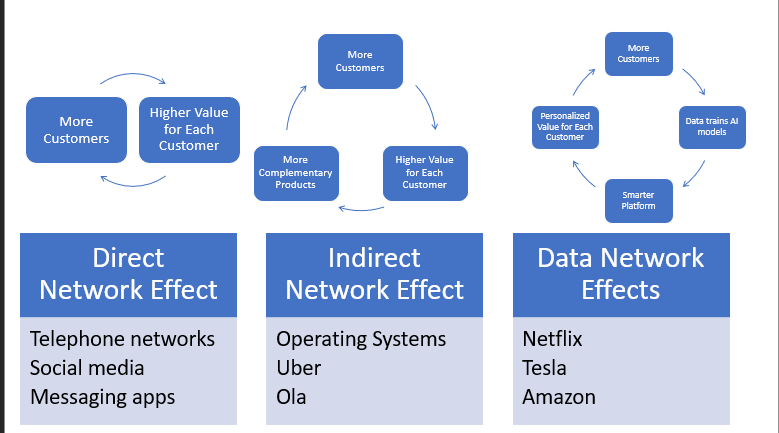Traditional network effects powered the last generation of tech giants. But in today’s data-rich, Gen AI-driven world, understanding only direct and indirect network effects isn’t enough for management teams.
We need to evolve our thinking to include Data Network Effects—where value compounds through data intelligence, not just user connections.
Here’s why this shift matters for every digital leader:  —
—
The Traditional Network Effects Framework
Direct Network Effects
What it is: More users make the platform more valuable for each user. Classic examples: Telephone networks, social media platforms, messaging apps.
The value equation: User A benefits directly from User B joining the platform.
Indirect Network Effects
What it is: More users in one segment attract more users in another segment. Classic examples: Operating systems (more users → more developers → better apps → more users).
The value equation: User growth in segment A drives value for segment B, which cycles back to benefit segment A.
Why Management Needs to Think Beyond Traditional Models
1. Data is the New Network Node In traditional models, value came from user-to-user connections. Today, each user interaction generates data that makes the platform smarter for everyone.
2. AI Amplifies Network Value Machine learning doesn’t just connect users—it learns from their behavior to create predictive, personalized experiences that compound over time.
3. Cross-Platform Intelligence Modern businesses operate across multiple touchpoints. Network effects now flow through integrated ecosystems, not isolated platforms.
Introducing Data Network Effects
Definition: Value increases as more users generate data that trains algorithms, improving the experience for all users—creating an intelligence moat.
How Data Network Effects Work:
Stage 1: Users interact → Generate behavioral data Stage 2: Data trains AI models → Platform gets smarter Stage 3: Smarter platform → Better user experience Stage 4: Better experience → More users → More data → Flywheel accelerates
Real-World Examples of Data Network Effects
Netflix:
- More viewers → Better recommendation algorithms → More personalized content discovery → Higher engagement → Attracts more content creators → Better content library → More viewers
Tesla:
- More drivers → More driving data → Better autopilot algorithms → Safer autonomous features → More attractive to buyers → More drivers
Amazon:
- More purchases → Better demand forecasting → Optimized inventory & logistics → Lower costs & faster delivery → More customer satisfaction → More purchases
Strategic Implications for Management
1. Rethink Your Data Strategy
Old thinking: Data is a byproduct of operations. New thinking: Data is a strategic asset that creates network effects.
Action: Audit what data you’re collecting, how it’s being used to improve user experience, and where intelligence gaps exist.
2. Design for Data Capture
Old thinking: Build features that users want. New thinking: Build features that users want AND generate valuable data.
Action: Every feature should answer: “How does this make our platform smarter?”
3. Invest in Feedback Loops
Old thinking: Users provide feedback through surveys. New thinking: User behavior provides continuous feedback through data.
Action: Create closed-loop systems where user actions automatically improve algorithmic performance.
4. Build Cross-Product Intelligence
Old thinking: Each product optimizes independently. New thinking: Data from Product A improves experience in Product B.
Action: Design unified data architectures that enable learning across your entire product ecosystem.
The Competitive Advantage Framework
Organizations that master Data Network Effects create three layers of defensibility:
Layer 1: User Network (Traditional) More users = more value per user
Layer 2: Data Intelligence (Modern) More data = smarter algorithms = better experience
Layer 3: Ecosystem Learning (Future-Ready) Cross-product intelligence = unified customer understanding = compound value creation
Action Items for Leadership Teams
Immediate (Next 30 Days):
- Map your current direct and indirect network effects
- Identify what data each user interaction generates
- Assess how that data currently improves user experience
Short-term (Next Quarter):
- Design data capture strategies for key user journeys
- Implement feedback loops between user behavior and product intelligence
- Establish metrics for measuring data network effect strength
Long-term (Next Year):
- Build cross-product data sharing capabilities
- Develop AI/ML capabilities that learn from user behavior
- Create ecosystem partnerships that enhance data network effects
The Bottom Line
Direct and indirect network effects got us here. Data network effects will take us forward.
In a world where every interaction generates data and AI can learn from that data to improve experiences, the organizations that win won’t just be those with the most users—they’ll be those with the smartest systems.
The question for every management team is: Are you building networks of users, or networks of intelligence?
Because in today’s world, intelligence compounds faster than connections.
What data network effects is your organization building? How are you turning user behavior into competitive advantage?
What soft skills have been most valuable in your leadership journey? Share your thoughts below.